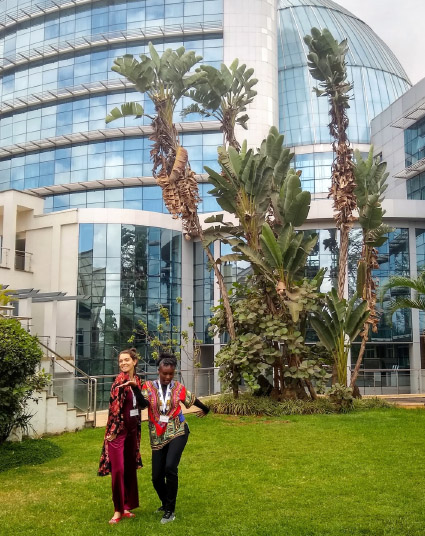 |
 |
 |
 |
notes from the field
This is a personal blog and does not reflect the views of the Red Cross Red Crescent Climate Centre
Sarah Posner
Kenya
June - September, 2019
Settling in and Beginning to Conceptualize the Impacts of Drought
August 7, 2019
View photo gallery for more photos in the field by Sarah Posner
 The last few weeks have flown by, and it is hard to believe I have already been in Nairobi for nearly a month! I have fully settled into my apartment, which is conveniently located near the Kenya Red Cross Headquarters. I look forward to my walks to work every morning and evening as part of my daily routine. They gave me a brand new desk at the office, which has been recently renovated and is sparkling clean. I was initially hesitant about the open office layout, but am finding it to be a refreshing reprieve from the isolation of my cubicle I was accustomed to at CU Boulder. The atmosphere is both friendly and professional, energized and collaborative, with the constant chatter of keyboards clicking and discussions in nearby board meetings. Every morning I am greeted by warm welcomes and freshly made chai which I am told requires at least two teaspoons of sugar! The workspace offers both opportunities for collaboration as well as the opportunity to make a few friends along the way.
The last few weeks have flown by, and it is hard to believe I have already been in Nairobi for nearly a month! I have fully settled into my apartment, which is conveniently located near the Kenya Red Cross Headquarters. I look forward to my walks to work every morning and evening as part of my daily routine. They gave me a brand new desk at the office, which has been recently renovated and is sparkling clean. I was initially hesitant about the open office layout, but am finding it to be a refreshing reprieve from the isolation of my cubicle I was accustomed to at CU Boulder. The atmosphere is both friendly and professional, energized and collaborative, with the constant chatter of keyboards clicking and discussions in nearby board meetings. Every morning I am greeted by warm welcomes and freshly made chai which I am told requires at least two teaspoons of sugar! The workspace offers both opportunities for collaboration as well as the opportunity to make a few friends along the way.
Last week, I attended a series of workshops held at the decadent Boma hotel owned by the Kenya Red Cross. The topics of discussion primarily surrounded flooding and the implementation of early warning and early action systems to forecast impacts. The data team presented their findings from fieldwork conducted recently to assess the impacts of the recent flooding events that occurred in Narok county earlier this year. There was shocking footage that depicted swift rivers running through the middle of towns and roads so severely eroded they formed deep, impassable crevices. These flood related impacts are short-onset in nature, which are visible on the landscape immediately following an event. This got me thinking about how droughts and related impacts which are more slow-onset in nature are inextricably linked.
While the main focus of Forecast-based-Financing (FbF) has been on floods, the tides are shifting to more of a focus on early action to mitigate impacts related to droughts, which has never been successfully implemented before. As part of my work on Forecast-based-Financing (FbF), I will be focused primarily on impacts-assessment to assess magnitudes of drought that will be used to set reliable thresholds for early action. On Friday, I met with my supervisor, Maurine Ambani, to discuss methodology and to start to develop the process of how to define the thresholds for drought-related impacts to define magnitudes that can be used as thresholds for early action. Based upon a set of prioritized indicators by key stake-holders in the last Technical Working Group (TWG) meeting, I am compiling an exhaustive list of what indicators have been used previously to measure drought-related impacts and at what spatial and temporal scale the data is available.
The work poses some serious challenges due to the nature of drought which is slow-onset and difficult to define. Drought means something different depending on who you ask, and there is no universal definition. In fact, Lloyd-Hughes (2014) argues that such a universal drought definition would be impossible to achieve, let alone impractical. This is because different people will feel different effects at varying degrees of severity, thus any definition should consider the context of drought mechanisms in a particular place. In East Africa, drought occurrence is frequent but has been difficult to forecast attributed to various natural and anthropogenic factors along with inefficient forecasting capacities (Gebremeskel et al., 2019). It is an insidious problem that, unlike other disasters, disasters related to drought continue to tighten their grip over time, destroying lives and livelihoods in its path, tearing at the social fabric of society by destroying entire areas. Recurrent drought impacts continue to undermine livelihoods and exacerbate local conditions of poverty, health, and food security as past events continue to repeat themselves (Muller, 2014). Thus, development interventions must shift from being crisis-driven to an impacts-focused approach to implement precautionary, rather than reactionary, interventions.
Gebremeskel Haile, G., Tang, Q., Sun, S., Huang, Z., Zhang, X., & Liu, X. (2019). Droughts in East Africa: Causes, impacts and resilience. Earth-Science Reviews, 193, 146–161, https://doi.org/10.1016/j.earscirev.2019.04.015.
Lloyd-Hughes, B. (2013). The impracticality of a universal drought definition. Theoretical and Applied Climatology,
Muller, J. C.-Y. (2014). Adapting to climate change and addressing drought – learning from the Red Cross Red Crescent experiences in the Horn of Africa. Weather and Climate Extremes, 3, 31–36, https://doi.org/10.1016/j.wace.2014.03.009.

